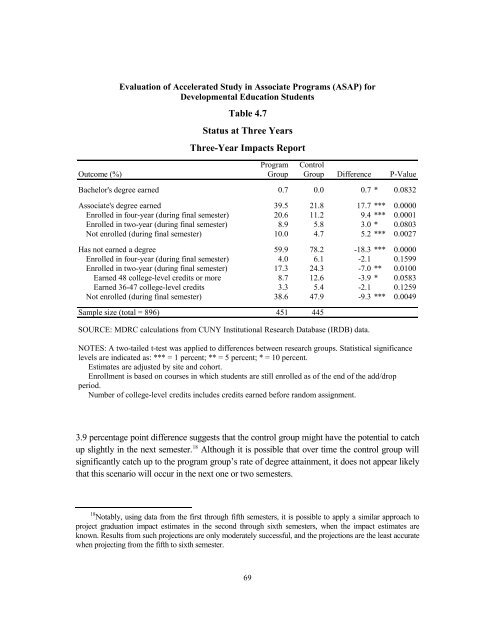1dOprzL
1dOprzL
1dOprzL
Create successful ePaper yourself
Turn your PDF publications into a flip-book with our unique Google optimized e-Paper software.
Evaluation of Accelerated Study in Associate Programs (ASAP) forDevelopmental Education StudentsTable 4.7Status at Three YearsThree-Year Impacts ReportProgram ControlOutcome (%) Group Group Difference P-ValueBachelor's degree earned 0.7 0.0 0.7 * 0.0832Associate's degree earned 39.5 21.8 17.7 *** 0.0000Enrolled in four-year (during final semester) 20.6 11.2 9.4 *** 0.0001Enrolled in two-year (during final semester) 8.9 5.8 3.0 * 0.0803Not enrolled (during final semester) 10.0 4.7 5.2 *** 0.0027Has not earned a degree 59.9 78.2 -18.3 *** 0.0000Enrolled in four-year (during final semester) 4.0 6.1 -2.1 0.1599Enrolled in two-year (during final semester) 17.3 24.3 -7.0 ** 0.0100Earned 48 college-level credits or more 8.7 12.6 -3.9 * 0.0583Earned 36-47 college-level credits 3.3 5.4 -2.1 0.1259Not enrolled (during final semester) 38.6 47.9 -9.3 *** 0.0049Sample size (total = 896) 451 445SOURCE: MDRC calculations from CUNY Institutional Research Database (IRDB) data.NOTES: A two-tailed t-test was applied to differences between research groups. Statistical significancelevels are indicated as: *** = 1 percent; ** = 5 percent; * = 10 percent.Estimates are adjusted by site and cohort.Enrollment is based on courses in which students are still enrolled as of the end of the add/dropperiod.Number of college-level credits includes credits earned before random assignment.3.9 percentage point difference suggests that the control group might have the potential to catchup slightly in the next semester. 18 Although it is possible that over time the control group willsignificantly catch up to the program group’s rate of degree attainment, it does not appear likelythat this scenario will occur in the next one or two semesters.18 Notably, using data from the first through fifth semesters, it is possible to apply a similar approach toproject graduation impact estimates in the second through sixth semesters, when the impact estimates areknown. Results from such projections are only moderately successful, and the projections are the least accuratewhen projecting from the fifth to sixth semester.69


